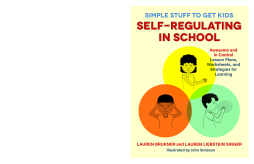
BOOK
Simple Stuff to Get Kids Self-Regulating in School
Lauren Brukner | Lauren Liebstein Singer | John Smisson
(2018)
Additional Information
Book Details
Abstract
Packed with photocopiable lesson plans and tried and tested strategies, this illustrated guide is the ideal companion for teachers and therapists wishing to help kindergarten and elementary school children to self-regulate. It contains everything you need to integrate the successful, research-based 'Awesome and In Control' program, which focuses on empowering children to regulate their own emotions and senses and helping them to develop excellent coping strategies.
Explaining how the popular, universal 'Awesome and In Control' program works, the guide enables you to help children to keep calm and in control during everyday tasks including reading, writing and paying attention to others.
Lauren Brukner is a senior occupational therapist. She specializes in sensory integration and self-regulation strategies for children and young people, and their implementation in home, school, and community settings.
Lauren Liebstein Singer is a Speech-Language Pathologist and a licensed Teacher of Students with Speech and Language Difficulties, currently working for the New York City Department of Education.
Table of Contents
| Section Title | Page | Action | Price |
|---|---|---|---|
| Simple Stuff to Get Kids Self-Regulating in School: Awesome and In Control Lesson Plans, Worksheets, and Strategies for Learning, by Lauren Brukner, MS, OTR/L and Lauren Liebstein Singer, MS, CCC-SLP, TSSLD | 3 | ||
| Hello and Welcome! | 10 | ||
| Part 1: Introducing the Program | 12 | ||
| 1. What is Universal Design for Learning, and Why is it So Important? | 14 | ||
| 2. The Background | 16 | ||
| 3. Basic Building Blocks of this Program | 18 | ||
| 4. All About Self-Regulation and Sensory Processing | 26 | ||
| 5. The Environment | 34 | ||
| 6. How to Use this Book | 44 | ||
| Part 2: The Lesson Plans | 50 | ||
| 7. Introducing the Awesome and In Control Program | 52 | ||
| 8. States of Regulation: Slow and Tired, Fast and Emotional, and Fast and Wiggly | 56 | ||
| Lesson 1: Slow and Tired Feelings | 56 | ||
| Lesson 2: Fast and Emotional Feelings | 60 | ||
| Lesson 3: Fast and Wiggly Feelings | 63 | ||
| 9. My Feelings are Unpredictable! Changes and Triggers | 66 | ||
| Lesson 4: My Feelings Change Throughout the Day, Part 1 | 66 | ||
| Lesson 5: My Feelings Change Throughout the Day, Part 2 | 70 | ||
| Lesson 6: What Does the Word Trigger Mean? | 72 | ||
| Lesson 7: My Triggers | 74 | ||
| Lesson 8: Our Feelings are Fluid | 78 | ||
| 10. Before We Begin: Let’s Make Breathing Concrete | 86 | ||
| Lesson 9: Exploring Tangible Breathing Focusers | 86 | ||
| 11 Making the Connection: What is an Anywhere Body Break? | 92 | ||
| Lesson 10: Exploring Anywhere Body Break Choices for Slow and Tired Feelings | 92 | ||
| Lesson 11: Exploring Anywhere Body Breaks for Fast and Emotional Feelings | 97 | ||
| Lesson 12: Exploring Anywhere Body Breaks for Fast and Wiggly Feelings | 100 | ||
| 12. Making the Connection: Exploring Tools | 104 | ||
| Lesson 13: Exploring Tools for Slow and Tired Feelings | 104 | ||
| Lesson 14: Exploring Tools for Fast and Emotional Feelings | 109 | ||
| Lesson 15: Exploring Tools for Fast and Wiggly Feelings | 112 | ||
| 13. Making the Connection: Big Body Breaks | 116 | ||
| Lesson 16: Understanding the Basics of the Movement Area within the Classroom | 116 | ||
| Lesson 17: Exploring Big Body Breaks for Slow and Tired Feelings | 123 | ||
| Lesson 18: Exploring Big Body Breaks for Fast and Emotional Feelings | 126 | ||
| Lesson 19: Exploring Big Body Breaks for Fast and Wiggly Feelings | 129 | ||
| Part 3: The Strategy Cards | 132 | ||
| 14. What are Strategy Cards? | 134 | ||
| Attentive Learning | 136 | ||
| Reading | 146 | ||
| Writing | 156 | ||
| Transitions | 166 | ||
| Lunch and Recess | 176 | ||
| Help! I Lost Control | 180 | ||
| I Can’t Get My Words Out | 190 | ||
| 15. Making Sure Strategies Stick | 194 | ||
| 16. Assessments | 200 | ||
| Bibliography | 210 | ||
| Acknowledgements | 212 | ||
| About the Authors | 214 | ||
| Blank Page | 1 |
